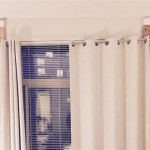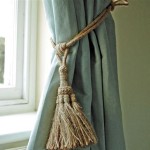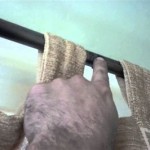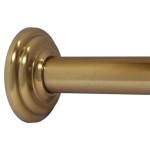Hanging Curtains in Plaster Walls
Plaster walls, a hallmark of older homes, offer a unique aesthetic appeal. However, their composition presents distinct challenges when hanging curtains, demanding careful consideration and specific techniques. Improper installation can lead to unsightly cracks, crumbling plaster, and insecure hangings. This article outlines the necessary steps and considerations for successfully hanging curtains on plaster walls.
Assessing the Wall Condition
Before attempting to hang anything, assess the plaster's condition. Look for existing cracks, loose sections, or areas where the plaster sounds hollow when tapped. These are signs of weakened plaster and require attention before proceeding. Filling minor cracks with spackle and allowing it to dry completely is crucial for a stable base. Larger areas of damage might require patching or professional repair to ensure the wall can support the weight of the curtains and hardware.
Choosing the Right Hardware
Selecting appropriate hardware is paramount for success. The weight of the curtains dictates the type of hardware needed. Heavy drapes require robust brackets and potentially even additional wall anchors. Lighter curtains provide more flexibility but still necessitate secure anchoring. Consider using specifically designed plaster screws or expanding anchors for optimal hold. These specialized fasteners are designed to grip the plaster securely without causing further damage.
Locating Studs
Whenever possible, anchoring curtain hardware directly into wall studs offers the most secure installation. Studs provide a solid foundation capable of supporting heavier curtains and minimizing stress on the plaster itself. A stud finder, either electronic or magnetic, can quickly locate studs behind the plaster. Mark the stud locations carefully for easy reference during installation.
Using Wall Anchors
When studs aren't in the desired location, wall anchors are essential. Several types of wall anchors work effectively in plaster. Toggle bolts offer excellent holding power for heavier curtains. Plastic expansion anchors are suitable for lighter weights. Self-drilling drywall anchors, while designed for drywall, can also function in plaster, though they offer less holding capacity. The choice of anchor depends on the weight of the curtains and the condition of the plaster.
Drilling Pilot Holes
Regardless of whether using screws directly into studs or with wall anchors, pre-drilling pilot holes is a critical step. Pilot holes prevent the plaster from cracking during installation. Use a drill bit slightly smaller than the screw or anchor being used. Drilling at a slow speed and applying gentle pressure minimizes the risk of further damage to the plaster. For particularly brittle plaster, consider using a masonry bit for the pilot hole.
Installing the Hardware
Once the pilot holes are drilled, carefully install the chosen hardware. Avoid over-tightening screws, as this can cause the plaster to crack. For toggle bolts, ensure the toggles are fully expanded behind the wall before tightening the screws. With plastic expansion anchors, tighten the screws until the anchor expands and grips the plaster firmly. Regular screws installed directly into studs should be driven snugly but not excessively tight.
Hanging the Curtains
After securely installing the hardware, hanging the curtains is the final step. Carefully slide the curtain rod or rings onto the brackets, ensuring proper alignment. Check the stability of the entire setup by gently tugging on the curtains. This verifies that the hardware is securely anchored and can support the weight. Addressing any instability immediately prevents potential damage to the plaster and ensures the longevity of the curtain installation.
Alternative Hanging Methods
For situations where drilling into the plaster is undesirable, consider alternative solutions. Adhesive hooks, designed specifically for heavier weights, can provide a non-invasive option for lighter curtains. Tension rods, which fit inside the window frame, eliminate the need for drilling altogether but are generally unsuitable for heavier drapes. These alternatives offer flexibility while preserving the integrity of the plaster walls.
Choosing the Right Curtains for Plaster Walls
The type of curtains selected also plays a role in minimizing stress on plaster walls. Opting for lighter fabrics, such as linen or cotton, reduces the weight load on the hardware and the wall. Avoid excessively heavy fabrics like velvet or heavily lined drapes, especially if the plaster is in questionable condition. Consider the length and fullness of the curtains as well. Shorter curtains put less strain on the hardware than floor-length drapes. Less fullness translates to less weight and therefore less stress on the plaster.

Hanging On Plaster Walls A How To For Curtains The White Apartment

How To Hang Curtains On Plaster Walls A Butterfly House

Hanging On Plaster Walls A How To For Curtains The White Apartment

How To Hang Curtains On Plaster Walls A Butterfly House

Hanging On Plaster Walls A How To For Curtains The White Apartment

How To Hang Curtains On Plaster Walls A Butterfly House

Re Hanging Curtains On Plaster Wall Doityourself Com Community Forums

Hanging On Plaster Walls A How To For Curtains The White Apartment

Hanging On Plaster Walls A How To For Curtains The White Apartment

Re Hanging Curtains On Plaster Wall Doityourself Com Community Forums








